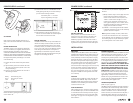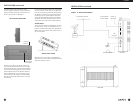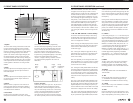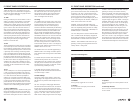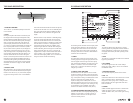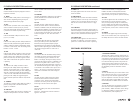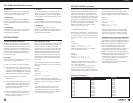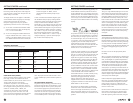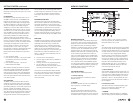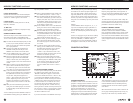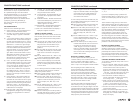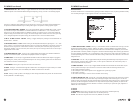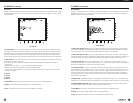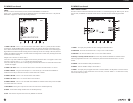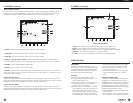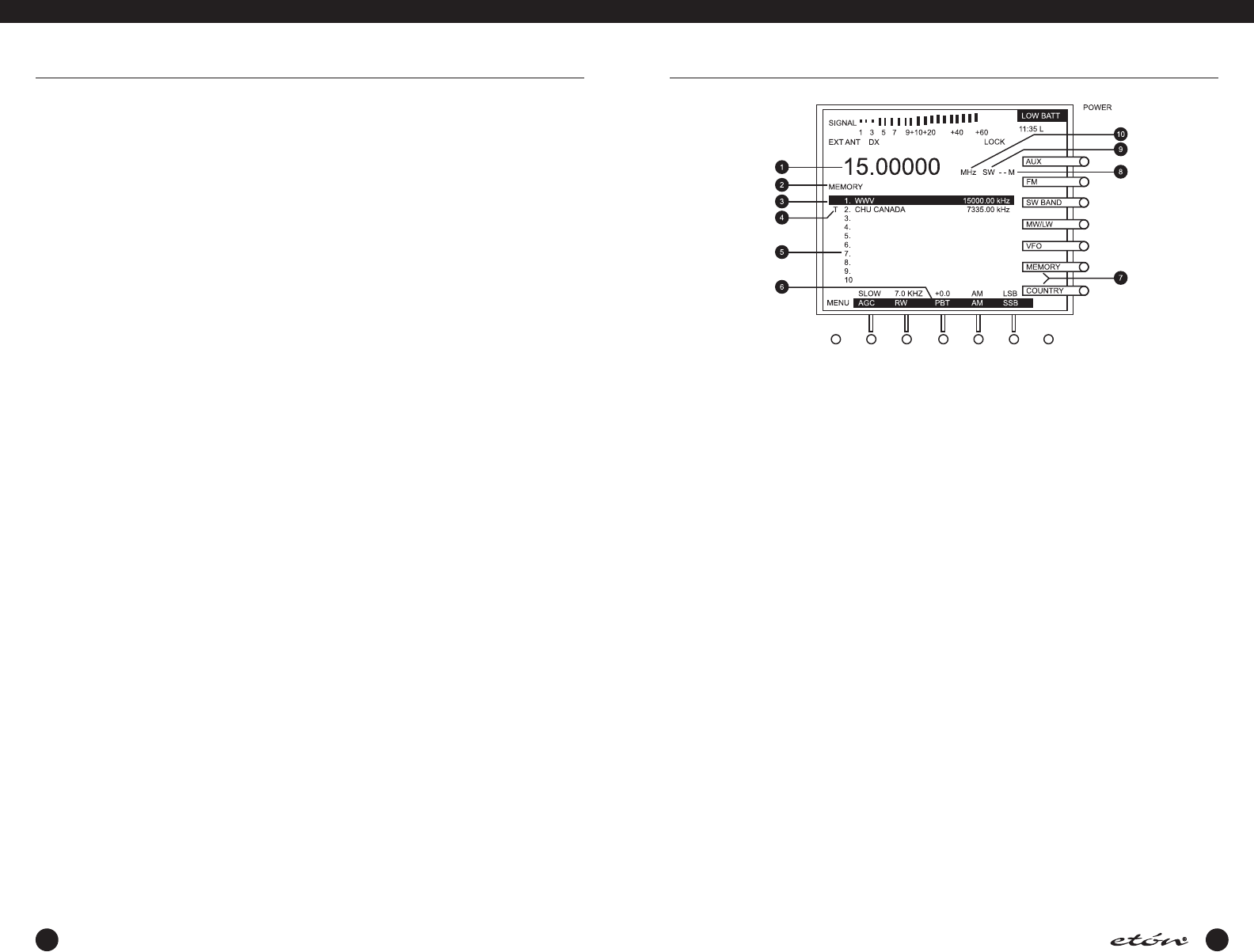
24 25
MEMORY DESCRIPTION
The E1 receiver contains 1700 memory channels that
can be used to store and recall commonly monitored
frequencies. The first 500 of these are referred to sim-
ply as MEMORY channels.The remaining 1200 are
referred to as COUNTRY channels. More on COUNTRY
in the next section. The 500 MEMORY channels are
displayed in groups of 10 per screen and each saved
frequency can be stored with an identifying name.They
can be scanned using the SEEK function which can
stop on any stored channel that has a predetermined
signal level, or the MEMORY channels can be scanned
selectively using the T.SCAN function.With MEMORY
channels programmed, you can use the T.SCAN func-
tion to selectively monitor desired MEMORY frequen-
cies. The following operating parameters may be stored
in any MEMORY channel: (1) Frequency, (2) Mode, (3)
Bandwidth, (4) AGC setting,(5) PBT setting,(6)
Synchronous Detector setting.
THE MEMORY DISPLAY
Please refer to the numbered figure above.
1. Channel Frequency
This is the frequency that is stored in the selected
MEMORY channel.
2. MEMORY
This indicator identifies the screen as a MEMORY dis-
play as opposed to a COUNTRY display.
3. Curser
This reverse video segment identifies the selected
MEMORY channel. This Curser is moved up or down
through the ten displayed channels one at a time using
the ‘TUNING’ knob or a page at a time (10 channels)
MEMORY FUNCTIONS
E
1 MANUAL
using the ‘< SELECT >’ key. If the ‘FAST / TUNING
LOCK’ key is pressed, the ‘TUNING’ knob will scroll
through the channels ten at a time.
4. T
This indicator marks this channel as being one selected
for T.SCAN. T.SCAN searches through all MEMORY and
COUNTRY channels marked with the ‘T’ and will ignore
all others.T.SCAN will stop in any channel marked with
a ‘T’ which has a signal strength greater than the
SQUELCH setting. It will proceed to the next marked
channel either based on a 5 second time interval, or
will stay on the channel on which it stopped until the
‘T.SCAN’ key is pressed again. Which of these T.SCAN
methods is used is determined by setting 2 in the
RADIO SETTINGS menu. The “T” tag is added to or
removed from the MEMORY channel on which the
curser rests by pressing the ‘TAG’ key.
5. Channel Numbers
These numbers identify the memory channels from 1 to
500, ten at a time.When the curser reaches the end of
a group of ten, the numbers displayed advance by ten.
For example if the curser were sitting on 10,and the
right hand ‘< SELECT >’ key was pressed, the curser
would jump to the top of the column with numbers 11
thru 20 displayed.
6. Function Key Labels
These labels, with their associated parameters, disap-
pear if you scroll through a channel that is pro-
grammed on an FM band frequency.
7. MEMORY
The ‘MEMORY’ softkey label appears as “MEMORY”
when the softkey is pressed, indicating that MEMORY
GETTING STARTED continued
PBT knob will cause ‘AM SYNC’ to flash on and off
temporarily until the system once again locks on to the
desired carrier.
FM OPERATION
FM reception is perhaps the easiest mode to use on
the etón E1 receiver.The AGC and BANDWIDTH set-
tings are not used in FM. In fact, all of the function
softkeys along the bottom edge of the display except
the ‘MENU’ softkey have no function on FM and the
labels on the display for these softkeys disappear.
Attempting to use one of these softkeys will result in
an ‘ERROR’ beep.All FM stations in the U.S. end in an
odd 100 kHz, i.e. 97.7 MHz, and are spaced 200 kHz
apart.The etón E1 receiver has the ability to tune in
20 kHz steps to allow tuning in between stations to
help eliminate interference to weaker stations that
could be covered up by stronger adjacent stations.
Additionally, when headphones are used, or if the LINE
OUT jack is fed into an external stereo sound system,
true stereo reception is possible.The ‘STEREO’ indicator
on the display will appear when a stereo station is
tuned in. ‘MONO’ will appear in this location if the
transmitting station is not in stereo, if no signal is
being received, or if MONO is selected from the AUDIO
SETTINGS menu. To select between STEREO and
MONO from the AUDIO SETTINGS menu, proceed as
follows:
• Press the ‘MENU’ softkey.
• Press the ‘Direct-Key-Input’ ‘2' key or press‘MENU’
two more times.This will access the AUDIO
SETTINGS menu.
• Press the ‘Direct-Key-Input’ ‘1' key to cycle
between MONO and STEREO.
When STEREO is enabled, the receiver will automati-
cally switch to stereo and provide left and right audio
from the HEADPHONE and LINE OUT jacks when a
stereo FM signal is being received. If the headphones
are removed while listening to a stereo broadcast the
receiver will provide monaural audio from the internal
or an external speaker.
AGC OPERATION
The etón E1 receiver provides the ability to select a
SLOW, FAST, or AUTO AGC setting. Each of the three
settings will permit automatic control of the receiver’s
gain thereby producing a constant audio output free of
distortion. Generally, the SLOW AGC setting is pre-
ferred for reception of AM and SSB signals. The FAST
AGC setting allows more rapid automatic receiver gain
adjustment to quickly fading signal levels.The AUTO
setting provides FAST AGC while tuning between sta-
tions to prevent the user from missing weak stations
between strong ones. However, once a station is tuned
in, it automatically switches to SLOW for smoother
audio output. The AGC does not function in the FM
mode.
MICROPROCESSOR RESET
A power-up reset routine will be activated anytime
after the receiver COMPLETELY loses power, from inter-
nal batteries and external DC input. However, short
term power failures of up to 10 minutes are masked by
an internal back-up capacitor.This will allow ample
time for battery replacement without loss of the inter-
nal clock. Note: Any programmed memory channels
and timer settings will NOT be lost under a power-up
reset due to the memory design of the etón E1 receiv-
er.
BEEP TONES
The etón E1 receiver responds to nearly all key depres-
sions with an audible beep unless the beep has been
disabled by means of menu entry 2 in AUDIO SET-
TINGS menu. This menu is accessed by pressing the
‘MENU‘ softkey three times, or by pressing the ‘MENU’
softkey once to access the MAIN MENU, and then
pressing the ‘\Direct-Key-Input’ ‘2' key. No beep is gen-
erated under any condition for depressions of the “ <
SELECT >” keys when in VFO mode. Beep tones indi-
cate the following:
• One short tone for a key depression.
• One short, high tone when storing a MEMORY or
COUNTRY channel.
• One long, low tone for any illegal key depression.
• Four quick beeps at one minute intervals if
batteries are installed, an external power source is
connected, and the external power is lost.
This feature must be enabled from AUDIO SETTINGS
menu item 3. Note that the volume of the beep tones
is controlled by the ‘VOLUME’ control, so if the ‘VOL-
UME’ control is turned all the way down, no beep
tones will be heard.



